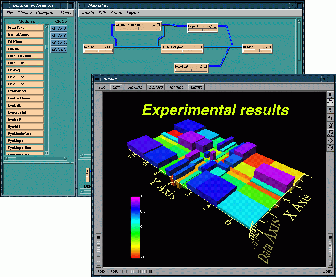
CERN, the European Laboratory for Particle Physics, who recently bought a complete range of software solutions from NAG, including IRIS Explorer, the numerical libraries and software tools, are planning to use IRIS Explorer with their next generation of experiments.
| A module written for CERN, to display 2D experimental data as a solid histogram, is shown here combined with existing modules to draw a set of axes, a legend and additional annotation. |

|
The great advantage of a system such as IRIS Explorer is the mixture of existing modules that form the basis of many a visualisation, and the ease with which bespoke modules may be generated.
CERN and NAG have joined forces and are each contributing their expertise in a project to convert from CERN's current visualisation tools to the IRIS Explorer environment. The collaboration is proving to be very fruitful, and already NAG have contributed a number of modules for the display of 1D and 2D results in a variety of ways.
NAG have also developed a module that will help in the process of laying out individual pictures on a page, to assist scientists with the interpretation of their experimental results. This module makes use of some of the new features of the Render module introduced at Release 3.5.
A module written to visualise 1D results was based on some NAG Graphics Library routines, thereby showing once again the ease with which proven software may be incorporated into IRIS Explorer code.
"We are pleased with the way the collaboration has been going", said Olivier Couet of the IT/ADS group, CERN. "The first prototypes to render 1D and 2D histograms are very promising. The next step will be to enhance the modules by making use of the G5G/TGS MasterSuite library which provides powerful tools for scientific data presentation. We look forward to using the results of our joint work in the future."
The recently announced G5G/TGS MasterSuite library is based - like IRIS Explorer - on Open Inventor and contains extensions which facilitate enhancements in 2D graphics, printing and user interface for Open Inventor applications.
Working with CERN, NAG will use MasterSuite to develop new modules for the display of 1D and 2D data. These and other enhancements (such as improved printing options) will be made available to other users in the next release of IRIS Explorer.